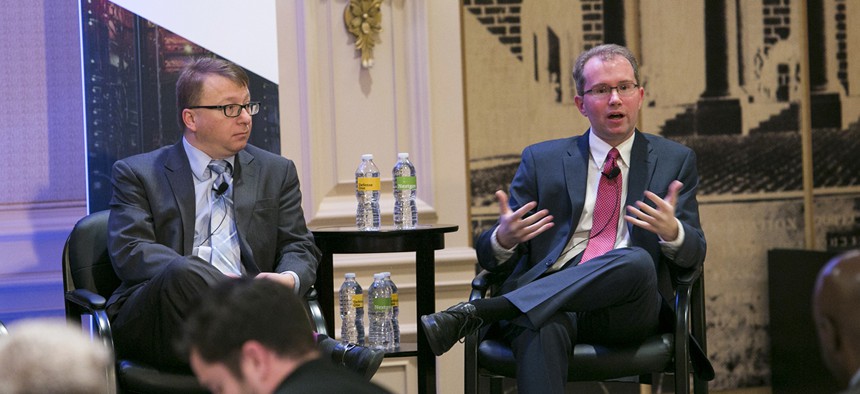Why Knowing What You Have Is Key to IT Modernization Efforts

Joint IT Service Provider - Pentagon CTO Thomas Sasala, left and FCC CIO David Bray, right, discusses IT modernization. Kristoffer Tripplaar
IT modernization is all the rage these days in the federal government.
They say you don’t know what you got ‘till it’s gone, but that’s especially true for federal agencies amid large-scale IT modernization efforts.
“Sometimes, the only time you know what you have in your house is when you move after 20 years,” said David Bray, the chief information officer at the Federal Communications Commission.
Bray, speaking today at an event hosted by Nextgov and Defense One, talked about the importance of inventorying servers, applications and “knowing what you have” across an organization. It’s a best practice, he said, for any agency looking to move its systems to platforms fit for the 21st century.
FCC did just that last year embarking on an effort to move its operations entirely to the cloud. Over Labor Day weekend, Bray said the agency “retired 100 servers on site,” and loaded the rest onto trucks toward a final destination within a commercial provider’s data center. An inventory of the agency’s IT assets, fueled in part by the agency’s plan to physically move locations, led to a direct savings through eliminating servers either redundant or simply taking up space.
IT modernization is all the rage these days in the federal government. Through the White House’s Cybersecurity National Action Plan, the Obama administration plans to establish a $3.1 billion revolving fund that agencies can borrow against – and pay back – to shore up their legacy IT systems. Even prior to the administration’s budget release, U.S. Chief Information Officer Tony Scott had called the government’s reliance on legacy IT a “crisis that’s bigger than Y2K.”
But any modernization efforts are reduced without a full IT inventory, including applications.
“Not having a comprehensive catalog of applications” was a major challenge, said Todd Simpson, who became the Food and Drug Administration’s sixth CIO in five years last May.
“The duplication taking place across FDA was draining resources and it was just taking us all overboard,” Simpson added.
Simpson responded by created a strategic plan containing some 130 deliverables “to improve efficiency and structure.” The plan called for actions like hiring a chief technology officer and getting approval to hire a chief data officer, as well as inventory the IT of an organization with a nationwide presence.
Simpson said FDA is “15.3 percent” along the way toward fully implementing the plan, though it’s taken hold across the organization amid structural changes FDA’s implemented.
“I just want to get our hands around what we have,” Simpson said.
FDA’s inventory effort is just one several initiatives Simpson has undertaken, along with a renewed importance placed on its innovation lab, cloud computing platforms and a customer-driven approach to networking.
NEXT STORY: 8 Things to Look For in the 2017 IT Budget



